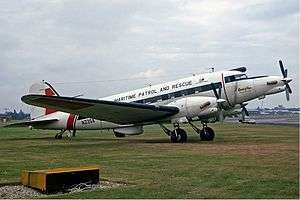Conroy Tri-Turbo-Three
| Tri-Turbo-Three | |
|---|---|
 | |
| Tri-Turbo-Three at Farnborough Airshow in 1978. | |
| Role | Conversion Kit |
| Manufacturer | Conroy Aircraft |
| First flight | 2 November 1977 |
| Status | Retired |
| Primary user | Polair Maritime Patrol & Rescue |
| Number built | 2 |
| Developed from | Conroy Turbo Three |
The Conroy Tri-Turbo-Three was a Douglas DC-3 fitted with three Pratt & Whitney Canada PT6 engines by Conroy Aircraft; the third engine was mounted on the nose of the aircraft.
Design and development
First flown on 2 November 1977,[1] the cruise speed of the aircraft was increased to 230 mph (200 kn; 370 km/h). The engine mounted on the nose could be shut off, decreasing the speed to 180 mph (160 kn; 290 km/h) and increasing the range of the aircraft. It was used by Polair and Maritime Patrol And Rescue. It was fitted with skis for use in Polar regions and flew in the North Pole region out of Resolute Bay Airport in Canada. It was uniquely suited for flying long distances and landing on rough, unprepared snow runways.
In this role it was instrumental in opening up the interior of Antarctica to private expeditions and tourism.[1] Most notable was a 1983 expedition transporting eight members of the Seven Summits expedition, plus a crew of three, to the Antarctic for a first-ever assault on Mount Vinson.[2]
In early May 1986 workers at the Santa Barbara Municipal Airport accidentally started a fire in the cockpit of this aircraft, which destroyed the cockpit. A second Tri-Turbo-Three was then manufactured out of the wreckage of the old plane and a different airframe.
Specifications
Data from The Illustrated Encyclopedia of Propeller Airliners[3]
General characteristics
- Crew: 3
- Capacity: 12,000 lb (5,443 kg) cargo
- Wingspan: 95 ft (29 m)
- Height: 18 ft 3 in (5.56 m)
- Wing area: 987 sq ft (91.7 m2)
- Max takeoff weight: 29,000 lb (13,154 kg) (PT6A-41)[4]
- Powerplant: 3 × Pratt & Whitney Canada PT6A-45 turboprop engines, 1,174 shp (875 kW) (ehp) each
Performance
- Cruise speed: 230 mph (200 kn; 370 km/h) (three engines) - 180 mph (160 kn; 290 km/h) (one engine stopped)
- Range: 2,700 mi (2,346 nmi; 4,345 km)
References
- 1 2 Air International November 1978, p. 252.
- ↑ Bass, Dick; Wells, Frank (1986). Seven Summits. Warner Books, Inc.
- ↑ Gunston 1980, p. 256.
- ↑ "15-bladed DC-3". Flight International, 23 September 1978, p. 1155.
- "Airdata File: Specialized Aircraft Tri Turbo-3". Air International, November 1978, Vol 15 No 5. p. 252.
- Gunston, Bill. The Illustrated Encyclopedia of Propeller Airliners. London: Windward/Phoebus, 1980. ISBN 0-7112-0062-9.
External links
| Wikimedia Commons has media related to Conroy Tri-Turbo-Three. |
- John M. Conroy
- Tri-Turbo 3 Goleta Air and Space Museum